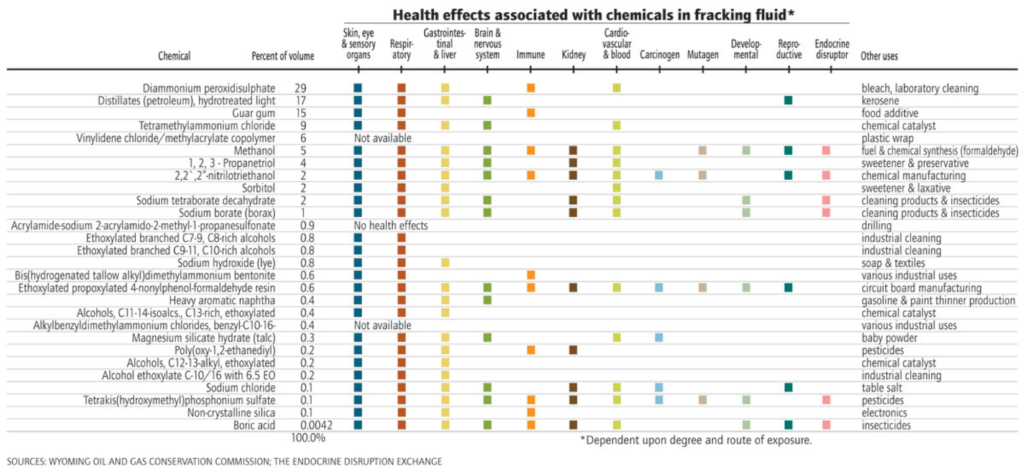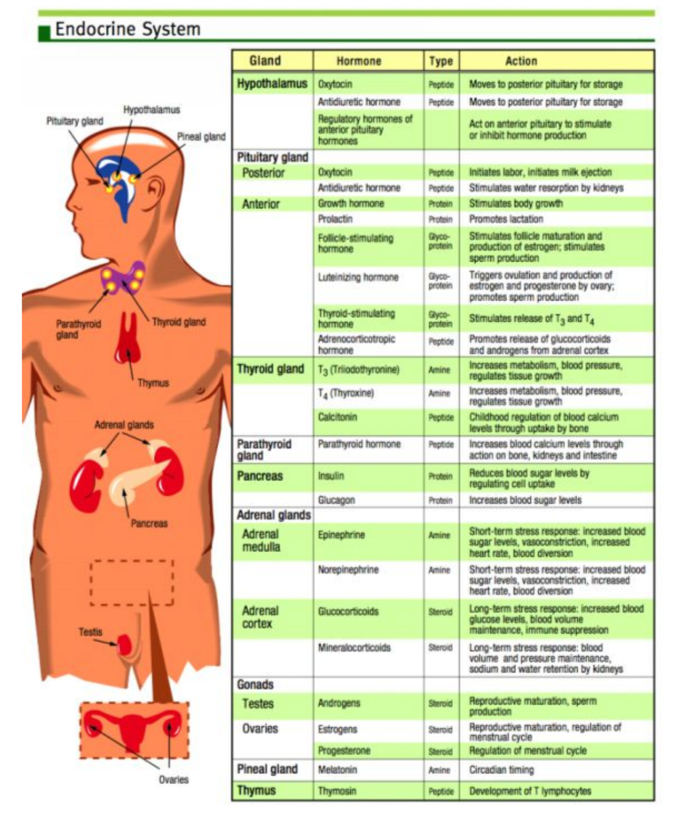HUMAN HEALTH AND ENVIRONMENTAL FINDINGS

ENDOCRINE DISRUPTION IN PLANTS AND HUMANS FROM Fracked Wastewater “PRODUCED WATER”
Endocrine System-Overview– By Patricia Reda B.S. RN
- 1 of 3 communications Systems in the body- Is a chemical Communication System¡- Secretes Hormones directly into the bloodstream targeting a specialized hormone receptors
- Controlled by a feedback loop¡- Hormones -act to stimulate or inhibit a cascade of events
- Comprised of-Pituitary, Hypothalamus, Pineal, Thyroid, Parathyroid, Adrenal, Islets of Langerhans (Pancreas) and Gonads- the Heart, Gastrointestinal Mucosa and the Placenta also have Endocrine Functions- There are at least 50 hormones.
- Function- balanced system of glands, organs, and hormones that regulates and controls vital functions: body growth, response to stress, sexual development, production of insulin and utilization of glucose, metabolism, neurodevelopment, intelligence, behavior, sleep patterns, blood pressure, and the ability to reproduce. Also controls the contraction of the smooth and cardiac muscles.
- Hormone and it’s receptor act as lock and key. It is precise.
- The endocrine system is so finely tuned that it depends upon changes in hormone concentrations comparable to one drop in 20 Olympic swimming pools

ENDOCRINE DISRUPTION AND DANGERS TO HUMAN, ANIMAL AND PLANT LIFE
Processed Water and the Endocrine System –Endocrine Disruption
Fracking chemicals mimic, interfere/block, or change the timing of hormonal actions to target cells. Common mimicked hormones are Estrogen and Androgens. Androgens are steroid hormones that regulates the development and maintenance of male characteristics by binding to androgen receptors.
Think of it as a player piano playing a tune correctly. Disruptors either add or subtract spines so the tune is corrupted, at times, making it unrecognizable.
23 commonly used fracking chemicals are linked to the inhibition of “estrogen, androgen, glucocorticoid, progesterone, and/or thyroid receptors”
RESULTS-
Disruption causes Diseases of the Endocrine, Reproductive, Neurological and Metabolic Systems. Examples- Infertility, endometriosis, early puberty, breast and prostate cancer, Alzheimer’s and Parkinson’s disease, Hypertension, Stroke, Birth Defects, Respiratory Disease ADHD, obesity, diabetes, asthma, immune disorders.
Immune system disorders cause abnormally low activity or over activity of the immune system. In cases of immune system over activity, the body attacks and damages its own tissues (autoimmune diseases). Immune deficiency diseases decrease the body’s ability to fight invaders, causing vulnerability to infections by bacteria or virus. This is true for humans, animals, and plant life.
Endocrine Disruption causes changes in cellular DNA meaning that the effects are delayed and may be passed on to future generations. We can inherit susceptibilities to disease because of Endocrine Disruption.
Hormones directly influence the Immune System. When ED is engaged, persons are more susceptible to diseases such as MS, neurological symptoms mimicking Polio, rampant cancer cell production, causing a myriad of Cancers.
Vulnerable population is persons during rapid developmental change- en utero, infancy, puberty, and menopause/andropause.
The Danger of Fracked Fluid on Human, Animal, and Plant Life – hundreds of tons of toxic chemicals are used in the fracking process.
The Endocrine Disruptor Exchange (TEDX) identified 353 chemicals used in fracking, many of which can cause cancer and other serious health, even in small doses. Many are proprietary, whose composition is unknown.
Brine contaminates include radium, a cancer-causing radioactive particle found deep within the shales. Radium half-life is over 1,000 years. Radium is water-soluble, all frack fluid used in the Shale becomes radioactive. Radio cludies are sometimes used in Fracking fluids.
Drilling wastewater is so poisonous, when a gas company that legally doused a patch of West Virginia forest with salty wastewater from a drilling operation, it killed ground vegetation within days and 60% of the trees within two years. Wastewater from fracking has also been linked to livestock and family pet deaths across the country.
Brine has a high salt concentration that has been recorded up to 10 times the salinity of ocean water and is highly toxic to plant and animal life.
No one doubts that fracking fluids have the potential to do serious harm. Theo Colbourn, an environmental health analyst and former director of the World Wildlife Fund’s wildlife and contaminants program, identified 632 chemicals used in natural-gas production. More than 75 percent of them, she said, could affect sensory organs and the respiratory and gastrointestinal systems; 40 to 50 percent have potential impacts on the kidneys and on the nervous, immune and cardiovascular systems; 37 percent act on the hormone system; and 25 percent are linked with cancer or mutations.
Fracking a single well requires up to 4-24 million gallons of water, plus an additional 400,000 gallons of additives, including lubricants, biocides, scale and rust inhibitors, solvents, foaming and defoaming agents, emulsifiers and de-emulsifiers, stabilizers and breakers. About 70 percent of the liquid that goes down a borehole eventually comes up—now further tainted with such deep-earth compounds as sodium, chloride, bromide, arsenic, barium, uranium, radium and radon. (These substances occur naturally, but many of them can cause illness if ingested or inhaled over time- heavily contaminated by the chemical mixtures that comprise the frack fluid, as well as dissolved salts and heavy metals from deep within the earth. Estimates from the industry indicate that drillers in Pennsylvania created approximately 19 million gallons of this wastewater per day in 2011 because of lax regulation, fracking companies commonly dispose of contaminated fracking water in the cheapest, easiest ways they can find, regardless of the consequences for communities, water treatment facilities, and the environment. This has led to abuses of waterways and communities close to frack sites.
18 barrels of brine are produced for each 1 barrel of oil and 3 barrels of brine for 1 barrel of gas.
Underground, petrochemicals can migrate along fissures through abandoned or orphaned wells or leaky well casings (the oil and gas industry estimates that 60 percent of wells will leak over a thirty-year period)
Exposure Pathways
Using state-of-the-art quantitative genetic sequencing, the scientists determined that the plants watered with the highest concentration of produced water had significant changes in expression of genes plants normally use to fight infections. Their study didn’t determine exactly which substances in the produced water correlated with suppressed immunity. But they hypothesized that a combination of contaminants like boron, petroleum hydrocarbons and salt caused the plants to reallocate metabolic resources to fight stress, making it more challenging for them to produce disease-fighting genes.
“Findings from this work suggest that plant immune response impacts must be assessed before reusing treated oil and gas wastewater for agricultural irrigation,” the study authors wrote.
Salts in brine impair plants’ ability to take up water and nutrients. High salt concentrations in the soil restrict the plants’ ability to take up water despite adequate water being available in the soil, exhibiting signs of drought. This is due to the osmotic effect, causing water to move from areas of low salt concentrations, in the roots, to areas of high salt concentrations, in the soil
Soil acidity increases in the vicinity of oil and gas pipelines where flaring occurs, reducing the amount of usable essential nutrients in the soil such as carbon, nitrogen, and phosphorous. The reduction of these nutrients makes it much more difficult for plants to grow and produce healthy vegetables and fruits.
When methane, the primary component of natural gas, leaks from gas pipelines it changes the oxygen and bacterial content of the soil. This reduces a plant’s ability to fix nitrogen (the process by which nitrogen, an essential nutrient, is made available for biological purposes), create cellulose (the essential component for plant growth), and also limits a plant’s ability to maintain proper hydration.
Heavy Metals – Fracking releases toxic heavy metals like arsenic, barium, cadmium, chromium, lead, and mercury into soils. Growing plants absorb these metals, which then enter the food chain. Humans and animals that eat these plants are exposed to these heavy metals, which can accumulate in body tissues and cause serious damage. Mercury, for example, is a highly potent neurotoxin. Eating food grown in soils contaminated with heavy metals poses a serious health risk.
Some institutions that specialize in risk, Nationwide Mutual Insurance, which sells agricultural insurance, recently announced that it would not cover damages related to fracking. Cattle are greatly effected: outright cattle death, stillborn births, milk production losses, neurological disorders, fertility disorders.
Radioactivity – Wastewater from fracking can contain radioactivity levels over 1000x the EPA’s recommended standard for drinking water. When wastewater is released into our streams and rivers without adequate radiation treatment, highly radioactive elements like uranium and radium, which had previously been safely trapped thousands of feet below the surface, can then enter the food chain and bioaccumulate in humans, plants, and animals just as heavy metals do.
Endocrine disruptors can cause problems such as male and female infertility in livestock and humans. A falling reproductive rate for livestock can have serious consequences on the sustainability of food production.
Surface water contaminated by improperly handled fracking fluids has killed many animals nationwide. Even a small spill of the highly toxic mixture can have large impacts on the surrounding livestock and wildlife. Unfortunately, animals are attracted to the saltiness of the fracking fluids, leading them to imbibe lethal quantities of the fluids and die.
When meat and produce are grown in toxic conditions, the toxic contamination doesn’t stop at the farm field. Contaminated fruits, vegetables, and meats can be shipped all over the country, potentially poisoning people hundreds or thousands of miles away from the frack source.¡- There is a growing concern of the inability of farmers to sell their crops if it is grown near fracking wells for fear of contamination.
The USGS has the largest dataset of water quality information on produced water, that I know of. Find that here.
https://journals.plos.org/plosone/article?id=10.1371/journal.pone.0175344
https://ccst.us/wp-content/uploads/160708-sb4-vol-II-6-1.pdf
https://www.sciencedirect.com/science/article/pii/S0883292718302713
https://doi.org/10.1016/S0958-2118(18)30119-8
https://doi.org/10.1089/ees.2007.0026
https://www.sciencebase.gov/catalog/item/57a50c48e4b0ebae89b6d87f
https://doi.org/10.1038/477271a
https://doi.org/10.1016/j.agwat.2018.05.006
https://doi.org/10.5066/F7X929H9
https://doi.org/10.5066/F72B8X8G
https://doi.org/10.5066/F7RN373C
https://doi.org/10.1155/2016/2707989
https://phys.org/news/2019-10-oil-gas-wastewater-irrigation-suppress.html?fbclid=IwAR3cRx7jbPBTghB7_3lz8NKZT2j2ggWF23EWmDPRn4o-feCo_Fu3lkxkjUQ. Hannah Miller et al, Food Crop Irrigation with Oilfield-Produced Water Suppresses Plant Immune Response, Environmental Science & Technology Letters (2019). DOI: 10.1021/acs.estlett.9b00539